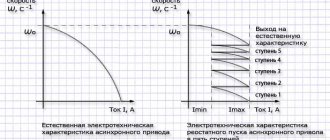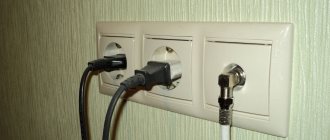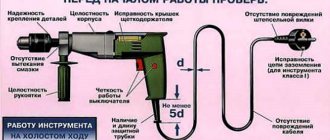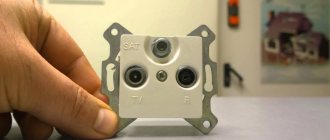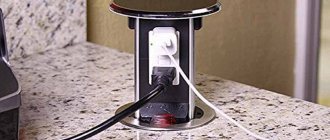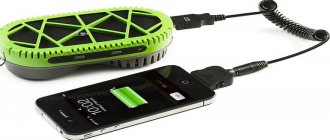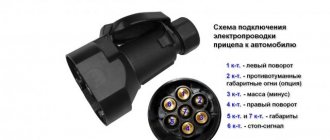Disadvantages of power tools and service life
It is well known that not every tool is equipped with such soft start circuits. They mainly come in expensive models from well-known brands Bosch, Hilti, and DeWalt. Moreover, both in the network line and in the battery one.
A power tool without such a device has a bunch of disadvantages:
- armature sparking on the commutator with armature lamellas burning out
- brushes burn out and wear out faster
- rotor and stator windings fail more often
- current surge into the general electrical network
- gears hitting each other and operating faster
- dangerous jerk when starting, tearing the tool out of your hands and increasing the risk of injury
When working with a miter saw with a PP, the blade will not stray from the prepared cutting point. Which is important for non-professional carpenters.
If at your dacha or in your house at the initial stage of construction there is no electricity yet and you use a generator, then sooner or later you will understand that without a soft start unit (soft start unit) with sharp initial currents, the generator will not last long. Therefore, such a thing can save not only the tool, but also emergency power supplies.
You can, of course, independently build a BPP into the inside of the same grinder or trimmer, but not everyone wants to disassemble the equipment and tinker with the insides.
Plus, opening a new case will void the warranty. Therefore, the best use for the KRRQD12A unit is external connection.
Just keep in mind that it is suitable for commutator motors. For asynchronous ones, a frequency generator with different regulation principles is needed.
This box is designed for a current of 12 Amps.
There is also a more powerful 20A model.
What is typical is that they have the same dimensions, but the difference in price is a couple of tens of rubles.
It would seem better to take it, but for a standard 16A socket the first option is more profitable. There will be no desire to connect a more powerful load and thereby burn all the contacts.
DIY craftsmen, of course, assemble similar circuits with their own hands, based on VTA 12-600 or other thyristors, capacitors, a dinistor and a couple of small resistors. You can find many examples of schemes on the Internet.
But for the average user of the instrument, it is much easier to buy all this in a ready-made compact case. You can order a similar block using the link here.
How to connect, installation
For users of angle grinders who do not have electrical installation skills, you can purchase a separately sold soft start unit. You will only need to install it correctly. There are two options for placing the starting device - inside the body of the angle grinder and, if not possible, outside.
In the next video, the author placed one of the purchased blocks inside it with the help of a slight modification of the angle grinder body. The two wires of the starting unit are connected according to the following diagram: one wire to the switch contact, the other to the stator winding of the electric drive.
In another video, the author also managed to place the purchased block inside the grinder. However, he chose a different connection scheme - to break the network. In this case, it is not important to consider where to connect the “zero” and where the “phase”.
Microcircuits k1182, LM358
The most famous microcircuit for the K1182 soft starter. This microcircuit was created back in Soviet times and now it is not so easy to find. There are other more affordable chips, for example, LM358. Many modern angle grinders use the LM358 chip in the factory version of the device.
Using an iron as an additional load to reduce the speed of an angle grinder
This method does not specifically relate to the topic of soft start of an angle grinder. However, to understand the principle of operation of an electronic device, a dimmer, which is used to adjust the power (or number of revolutions) of an angle grinder, is quite acceptable. In the next video, the iron takes a certain power from the angle grinder, thereby reducing its speed.
Soft starters with three wires
By the way, be careful, there are similar devices, but with three wires. For example XS-12/D3.
Or other models that look similar to KRRQD.
But they are assembled on a slightly different principle and need to be installed after the START button, in the instrument itself. Voltage should be applied to them only at the moment the grinder's start button is closed and immediately disappear after it is released.
The connection diagram for them is as follows:
The phase is supplied to contact “A”, zero to “C”. Next, the phase with the output control wire goes to the engine (this is exactly the third wire).
Without a button, such a device will be constantly powered by 220V, which is not acceptable.
There is no such thing in a two-wire unit, since it is connected to an open circuit, and voltage (potential difference) is applied to it only at the moment of starting and operating the tool.
Another point is the so-called electric brake or brake winding on the crosscuts. It may not work with a 3-wire external soft starter, but it will work with a 2-wire model.
What is it for?
If the tool is not equipped with a speed controller, then it does not need one. An angle grinder, for example, is always used at full speed, otherwise it becomes dangerous. Why does such a power tool need a soft start? There are many reasons, because a sharp start of the engine of the same grinder or electric jointer causes:
- burnout of brushes and rotor lamellas;
- electric shock in the electrical network;
- an attempt of the instrument to escape from the hands, which is unsafe;
- strong starting impact of the gears of the gearbox against each other, causing their rapid wear.
With a smooth start, neither current nor mechanical shock will occur. The power tool engine will start smoothly and reach maximum speed.
Manufacturing a soft start socket
The most important requirement for such an outlet is its mobility. Therefore, you will need a carrier.
With its help, you can smoothly launch the tool anywhere - in the garage, at the dacha, during the construction of your house in different areas of the construction site.
The first step is to disassemble the carrier.
The main power wires in it can be either soldered or connected to screw terminals.
Depending on this, your additional outlet will also be connected. This should be an additional socket near the carrying case in order to be able to simultaneously connect the instrument in different modes.
By the way, if you mistakenly turn on an angle grinder or circular saw that has a factory built-in soft start into an outlet that is also equipped with such a soft starter, then surprisingly everything will work. The only thing is that there will be a delay in starting the saw or turning the disk for a couple of seconds, which is not very convenient to use and can be puzzling if you don’t get used to it.
Here are real tests of such a connection, carried out by one master from YouTube BaRmAgLoT777. His comment after such tests on a Dremel type engraver, a Bosch drill, a Makita router, and an Interskol circular saw:
Next, to assemble the socket, take a stranded copper wire with a cross-section of 2.5 mm2 and strip its ends.
Then you need to tin the contact pad on the carrier where this wire will be soldered.
Securely solder the cable cores to these pads.
Carefully lay out the wires and close the extension cord.
Take a square external socket for installation on the outer surface of the walls, and try on a soft starter unit in its housing. Since it has compact rectangular dimensions, it should fit there without any problems.
Mount and secure the socket body on the same platform as the extension cord.
The PP block is connected to the gap of any wire, phase or neutral. Do not confuse it, phase and zero are not supplied to it at the same time, i.e. 220V.
It is installed on one of the wires.
Also for this BPP, there is no difference on which side to make the entrance and on which side to make the exit. The twists are soldered and insulated with heat shrink.
After that, all the insides of the socket are assembled into a housing and all that remains is to close the entire structure with a lid.
At this point, the entire reworking of the carrying case and the manufacture of the socket can be considered complete. It will take you no more than 15 minutes.
How to make a soft start yourself
Due to the simplicity of the circuit, it is not difficult to assemble a soft start device for an electric motor using a triac. It is made from available parts. It is best to do it on a printed circuit board, so nothing will dangle and short out. The triac must be mounted on a heat sink made of aluminum. It is better if it is a factory radiator designed for a power of 10-30 W. Then it is suitable for power tools with a power of 1000-1200 W.
Calculating the radiator is very simple by calculating the current. The triac voltage drops about 1.5-2 volts when it is open. The current is obtained by dividing the power by the mains voltage. For example, a power tool rated at 1200 watts: 1200/220 = 5.45 amps. Multiply by 2, we get 11 W.
Usually, in a commercial power tool, the power limiting circuit is hidden somewhere in the handle or body of the angle grinder or drill. There is no way to place a normal radiator there. If it is started frequently, it overheats and does not perform its functions. Only a good professional power tool has a normal device for limiting the starting torque and adjusting the speed.
NOTE : It is best to make a soft start module for a power tool in a box with a socket. Do not use outlet boxes that are too small. It is difficult to place a normal radiator for a triac there. Without a radiator, the device will be of no practical use! When assembling the radiator with the device, it is necessary to ensure the cleanliness of the mating surfaces and a thin layer of heat-conducting paste (KTP-8 or an imported analogue).
The radiator must be mounted on the same board on which the other parts are assembled. The board is placed in a box of suitable dimensions and is quite durable. These boxes can be purchased from electrical supply stores or made from sheet plastic. A clean, empty glue or paint can with a screw-on or tight-fitting lid may work. It must be durable and unbreakable.
The socket installed in the device must be rated for the rated current of the electric motor used. It's a similar story with the power cord.
IMPORTANT! If the power tool is equipped with a speed controller, its handle must be securely insulated. The device is under mains voltage and may be a source of electric shock if the insulation is poor.
After installation, it is useful to coat the printed circuit board with nitro varnish to protect it from moisture. The schematic diagram and analysis of its operation are in the next section.
Soft start on the KR1182PM1 microcircuit
This is a microcircuit for Russian-made power tools, which is produced by CJSC “NTC SIT” (Bryansk). It can be purchased retail in many online stores. Also new name K1182MP1R.




